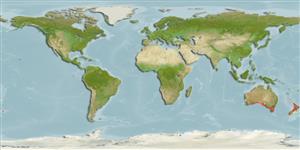Common names from other countries
Environment: milieu / climate zone / depth range / distribution range
Ecologia
marinhas demersal; intervalo de profundidade 20 - 200 m (Ref. 9563). Temperate; 29°S - 47°S, 113°E - 176°W
Indo-West Pacific: New Zealand and Australia (southern Western Australia to New South Wales and Tasmania).
Tamanho / Peso / Idade
Maturity: Lm ? range ? - ? cm
Max length : 31.0 cm TL macho/indeterminado; (Ref. 9563); common length : 25.0 cm TL macho/indeterminado; (Ref. 9258)
Descrição breve
Chaves de identificação | Morfologia | Morfometria
Espinhos dorsais (total) : 2; Raios dorsais moles (total) : 32 - 38; Raios anais moles: 31 - 36. Scales small with numerous tiny spinules, prominent first dorsal spine above eyes (Ref. 9002).
Inhabits rocky weedy areas from the shore to at least 60 m. Generally solitary but may aggregate in groups of 10-15 individuals in midwater. Feeds mainly on sessile and encrusting organisms, with sponges and ascidians predominating (Ref. 26966); also seen feeding mid-water on zooplankton and likes to bite diver's fingers (Ref. 9002).
Life cycle and mating behavior
Maturities | Reprodução | Spawnings | Egg(s) | Fecundities | Larvas
Armitage, R.O., D.A. Payne, G.J. Lockley, H.M. Currie, R.L. Colban, B.G. Lamb and L.J. Paul (eds.), 1994. Guide book to New Zealand commercial fish species. Revised edition. New Zealand Fishing Industry Board, Wellington, New Zealand, 216 p. (Ref. 9258)
Categoria na Lista Vermelha da IUCN (Ref. 130435)
CITES (Ref. 128078)
Not Evaluated
Ameaça para o homem
Harmless
Utilização humana
Pescarias: espécies comerciais
Ferramentas
Relatórios especiais
Descarregue XML
Fontes da internet
Estimates based on models
Preferred temperature (Ref.
115969): 13.4 - 17.7, mean 15.1 (based on 141 cells).
Phylogenetic diversity index (Ref.
82804): PD
50 = 0.5039 [Uniqueness, from 0.5 = low to 2.0 = high].
Bayesian length-weight: a=0.02754 (0.01477 - 0.05134), b=2.97 (2.81 - 3.13), in cm Total Length, based on LWR estimates for this species & (Sub)family-body (Ref.
93245).
Nível Trófico (Ref.
69278): 3.1 ±0.0 se; based on diet studies.
Resiliência (Ref.
120179): Médio, tempo mínimo de duplicação da população 1,4 - 4,4 anos (Assuming tm=2).
Fishing Vulnerability (Ref.
59153): Low to moderate vulnerability (27 of 100).
Climate Vulnerability (Ref.
125649): Moderate to high vulnerability (49 of 100).
